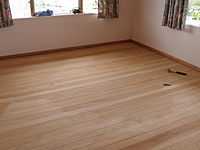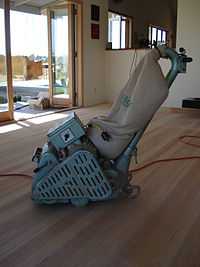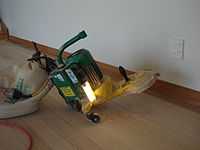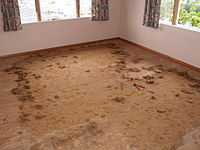Floor sanding



Floor sanding is the process of removing the top surfaces of a wooden floor by sanding with abrasive materials.
A variety of floor materials can be sanded, including timber, cork, particleboard, and sometimes parquet. Some floors are laid and designed for sanding.[1] Many old floors are sanded after the previous coverings are removed and suitable wood is found hidden beneath. Floor sanding usually involves three stages: Preparation, sanding, and coating with a protective sealant.
Machines
Almost all modern sanding jobs are completed with specialized sanding machines. The majority of material is removed by large belt or drum sanders.[2] The areas where the large sanders cannot reach, such as edges, corners, and stairs, are sanded by an edger. A finishing machine is then used for the final sanding.
Process
Preparation is the first stage of the sanding process. All nails which protrude above the boards are punched down. Nails can severely damage the sanding machines which are being used. Staples or tacks used to fasten previous coverings (if any) are removed to reduce the possibility of damage. Some brands or types of adhesives which have been used to secure coverings may need to be removed. Some adhesives clog papers and running gear of the machines used, and some can even make sanding impossible.
After the floor is prepared, the sanding begins. The first cut is done with coarse-grit papers to remove old coatings and to make the floor flat. The differences in height between the boards are removed. The large sanders are used across the grain of the timber. The most common paper used for the first cut is 40 grit.[2] The areas which cannot be reached by the large sanders are sanded by an edger, at the same grit paper as the rest of the floor. If filling of holes or boards is desired this is the stage where this is usually done. 80 grit papers are usually used for the second cut. The belt sander is used inline with the grain of the timber in this cut. A finishing machine is then used to create the final finish. The grit paper used is of personal preference, however 100-150 grit papers are usually used.
The sanded floor is coated with polyurethane, oils, or other sealants. If it is an oil-based sealant, then it is highly poisonous, having a high volatile organic compound[3] content, so wearing a suitable respirator mask[4] is recommended.
Issues
Sanding removes all patina, and can change the character of old floors. The result does not always suit the character of the building.
Sanding old boards sometimes exposes worm eaten cores, effectively ruining the floor's appearance. This can reduce the sale price, or even cause the floor to require replacement.
Sanding removes material, and timber floors have a limit to how much they can be sanded.
References
- ↑ Newnes (1984). Newnes all colour reference DIY and home improvement. London: Newnes Books.
- ↑ 2.0 2.1 Sanding London (2015). "Drum Sander". Retrieved 2015-02-25.
- ↑ "Volatile organic compound". Wikipedia.
- ↑ "Respirator mask". Wikipedia.
